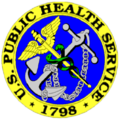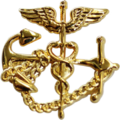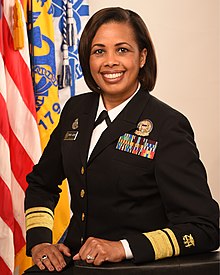Surgeon General of the United States
| Surgeon General of the United States | |
|---|---|
 Seal of the United States Public Health Service, 1798 | |
 Flag of the United States Surgeon General | |
| Public Health Service Public Health Service, Commissioned Corps | |
| Reports to | United States Assistant Secretary for Health |
| Seat | Hubert H. Humphrey Building, United States Department of Health and Human Services (HHS), Washington, D.C. |
| Appointer | The President with United States Senate advice and consent |
| Term length | 4 years |
| Formation | March 29, 1871 |
| First holder | John M. Woodworth (as Supervising Surgeon) |
| Website | www.SurgeonGeneral.gov |
The Surgeon General of the United States is the operational head of the U.S. Public Health Service Commissioned Corps (PHSCC) and thus the leading spokesperson on matters of public health in the federal government of the United States. The Surgeon General's office and staff are known as the Office of the Surgeon General (OSG).
The U.S. Surgeon General is nominated by the President of the United States and confirmed by the Senate. The Surgeon General must be appointed from individuals who (1) are members of the Regular Corps of the U.S. Public Health Service, and (2) have specialized training or significant experience in public health programs.[1] The Surgeon General serves a four-year term of office and, depending on whether or not the current Assistant Secretary for Health is a Public Health Service commissioned officer, is either the senior or next most senior uniformed officer of the commissioned corps, holding the rank of a vice admiral.[2][3] The current Acting Surgeon General is Rear Admiral Sylvia Trent-Adams.[4]
Responsibilities

The Surgeon General reports to the Assistant Secretary for Health (ASH), who may be a four-star admiral in the commissioned corps, and who serves as the principal adviser to the Secretary of Health and Human Services on public health and scientific issues. The Surgeon General is the overall head of the Commissioned Corps, a 6,500-member cadre of uniformed health professionals who are on call 24 hours a day, and can be dispatched by the Secretary of HHS or the Assistant Secretary for Health in the event of a public health emergency.
The Surgeon General is also the ultimate award authority for several public health awards and decorations, the highest of which that can be directly awarded is the Surgeon General's Medallion (the highest award bestowed by board action is the Public Health Service Distinguished Service Medal). The Surgeon General also has many informal duties, such as educating the American public about health issues and advocating healthy lifestyle choices.
The office also periodically issues health warnings. Perhaps the best known example of this is the Surgeon General's warning label that has been present on all packages of American tobacco cigarettes since 1966. A similar health warning has appeared on alcoholic beverages labels since 1988.
History


In 1798, Congress established the Marine Hospital Fund, a network of hospitals that cared for sick and disabled seamen. The Marine Hospital Fund was reorganized along military lines in 1870 and became the Marine Hospital Service—predecessor to today’s United States Public Health Service. The service became a separate bureau of the Treasury Department with its own staff, administration, headquarters in Washington, D.C, and the position of Supervising Surgeon (later Surgeon General).[5]
After 141 years under the Treasury Department, the Service came under the Federal Security Agency in 1939, then the Department of Health, Education, and Welfare (HEW) in 1953, and finally the United States Department of Health and Human Services (HHS).
Some Surgeons General are notable for being outspoken and/or advocating controversial proposals on how to reform the U.S. health system.[citation needed] The office is not a particularly powerful one, and has little direct statutory impact on policy-making, but Surgeons General are often vocal advocates of precedent-setting, far-sighted, unconventional, or even unpopular health policies.
- On January 11, 1964, Rear Admiral Luther Terry, M.D., published a landmark report saying that smoking may be hazardous to health,[6] sparking nationwide anti-smoking efforts. Terry and his committee defined cigarette smoking of nicotine as not an addiction. The committee itself consisted largely of physicians who themselves smoked. This report went uncorrected for 24 years.[7]
- In 1986, Vice Admiral Dr. C. Everett Koop's report on AIDS called for some form of AIDS education in the early grades of elementary school, and gave full support for using condoms for disease prevention.[8] He also resisted pressure from the Reagan administration to report that abortion was psychologically harmful to women, stating he believed it was a moral issue rather than one concerning the public health.
- In 1994, Vice Admiral Dr. Joycelyn Elders had spoken at a United Nations conference on AIDS. She was asked whether it would be appropriate to promote masturbation as a means of preventing young people from engaging in riskier forms of sexual activity, and she replied, "I think that it is part of human sexuality, and perhaps it should be taught."[9] Elders had also spoken in favor of studying drug legalization. In a reference to the national abortion issue, she said "We really need to get over this love affair with the fetus and start worrying about children."[10] She was fired by President Bill Clinton in December 1994
The U.S. Army, Navy, and Air Force also have officers overseeing medical matters in their respective services who hold the title Surgeon General.
The insignia of the Surgeon General, and the USPHS, use the caduceus as opposed to the Rod of Asclepius.
Service rank

The Surgeon General is a commissioned officer in the U.S. Public Health Service Commissioned Corps, one of the seven uniformed services of the United States, and by law holds the rank of vice admiral.[3] Officers of the Public Health Service Commissioned Corps are classified as non-combatants, but can be subjected to the Uniform Code of Military Justice (UCMJ) and the Geneva Conventions when designated by the Commander-in-Chief as a military force or if they are detailed or assigned to work with the armed forces. Officer members of these services wear uniforms that are similar to those worn by the United States Navy, except that the commissioning devices, buttons, and insignia are unique. Officers in the U.S. Public Health Service wear unique devices that are similar to U.S. Navy, Staff Corps Officers (e.g., Navy Medical Service Corps, Supply Corps, etc.).
The only Surgeon General to actually hold the rank of a four-star admiral was David Satcher (born 1941, served 1998–2002). This was because he served simultaneously in the positions of Surgeon General (three-star) and Assistant Secretary for Health (which is a four-star office).[11] John Maynard Woodworth (1837–1879, served 1871–1879), the first holder of the office as "Supervising Surgeon", is the only Surgeon General to not hold a rank.
Surgeons General of the United States
| № | Name (birth–death) |
Photo | Term of office | Appointed by (term) | |
|---|---|---|---|---|---|
| Start of term | End of term | ||||
| 1 | John M. Woodworth (1837–1879) |

|
March 29, 1871 | March 14, 1879 | Ulysses S. Grant (1869–1877) |
| 2 | RADM John B. Hamilton (1847–1898) |

|
April 3, 1879 | June 1, 1891 | Rutherford B. Hayes (1877–1881) |
| 3 | RADM Walter Wyman (1848–1911) |

|
June 1, 1891 | November 21, 1911 | Benjamin Harrison (1889–1893) |
| 4 | RADM Rupert Blue (1868–1948) |

|
January 13, 1912 | March 3, 1920 | William Howard Taft (1907–1913) |
| 5 | RADM Hugh S. Cumming (1869–1948) |

|
March 3, 1920 | January 31, 1936 | Woodrow Wilson (1913–1921) |
| 6 | RADM Thomas Parran, Jr. (1892–1968) |

|
April 6, 1936 | April 6, 1948 | Franklin D. Roosevelt (1933–1945) |
| 7 | RADM Leonard A. Scheele (1907–1993) |

|
April 6, 1948 | August 8, 1956 | Harry S. Truman (1945–1953) |
| 8 | RADM Leroy Edgar Burney (1906–1998) |

|
August 8, 1956 | January 29, 1961 | Dwight D. Eisenhower (1953–1961) |
| 9 | RADM Luther Terry (1911–1985) |

|
March 2, 1961 | October 1, 1965 | John F. Kennedy (1961–1963) |
| 10 | VADM William H. Stewart (1921–2008) |

|
October 1, 1965 | August 1, 1969 | Lyndon B. Johnson (1963–1969) |
| N/A | RADM Richard A. Prindle (c. 1926–2001) Acting Surgeon General |
August 1, 1969 | December 18, 1969[12][13] | Richard Nixon (1969–1974) | |
| 11 | RADM Jesse Leonard Steinfeld (1927–2014) |

|
December 18, 1969[14] | January 30, 1973[15] | |
| N/A | RADM S. Paul Ehrlich, Jr. (1932–2005) Acting Surgeon General |
January 31, 1973[16] | July 13, 1977 | ||
| 12 | VADM Julius B. Richmond (1916–2008) |

|
July 13, 1977 | January 20, 1981[17] | Jimmy Carter (1977–1981) |
| N/A | Edward Brandt, Jr. (1933–2007) Acting Surgeon General |
May 14, 1981 | January 21, 1982 | Ronald Reagan (1981–1989) | |
| 13 | VADM C. Everett Koop (1916–2013) |

|
January 21, 1982 | October 1, 1989 | |
| N/A | ADM James O. Mason (1930–) Acting Surgeon General |

|
October 1, 1989 | March 9, 1990 | George H. W. Bush (1989–1993) |
| 14 | VADM Antonia C. Novello (1944–) |

|
March 9, 1990 | June 30, 1993 | |
| N/A | RADM Robert A. Whitney (1935–) Acting Surgeon General |

|
July 1, 1993 | September 8, 1993 | Bill Clinton (1993–2001) |
| 15 | VADM Joycelyn Elders (1933–) |
September 8, 1993 | December 31, 1994 | ||
| N/A | RADM Audrey F. Manley (1934–) Acting Surgeon General |

|
January 1, 1995 | July 1, 1997 | |
| 16 | ADM[11] / VADM David Satcher (1941–) |

|
February 13, 1998 | February 12, 2002 | |
| N/A | RADM Kenneth P. Moritsugu (1945–) Acting Surgeon General |

|
February 13, 2002 | August 4, 2002 | George W. Bush (2001–2009) |
| 17 | VADM Richard Carmona (1949–) |

|
August 5, 2002 | July 31, 2006 | |
| N/A | RADM Kenneth P. Moritsugu (1945–) Acting Surgeon General |

|
August 1, 2006 | September 30, 2007 | |
| RADM Steven K. Galson (1956–) Acting Surgeon General |

|
October 1, 2007 | October 1, 2009 | ||
| RADM Donald L. Weaver Acting Surgeon General |

|
October 1, 2009 | November 3, 2009 | Barack Obama (2009–2017) | |
| 18 | VADM Regina Benjamin[18] (1956–) |

|
November 3, 2009[19] | July 16, 2013 | |
| N/A | RADM Boris D. Lushniak Acting Surgeon General |

|
July 17, 2013 | December 18, 2014 | |
| 19 | VADM Vivek Murthy (1977–) |

|
December 18, 2014 | April 21, 2017 | |
| N/A | RADM Sylvia Trent-Adams Acting Surgeon General |

|
April 21, 2017 | Incumbent | Donald Trump (2017-) |
See also
- Surgeon General
- Surgeon General of the United States Army
- Surgeon General of the United States Navy
- Surgeon General of the United States Air Force
- Medical Officer of Health
- Chief Public Health Officer of Canada
- Chief Medical Officer (United Kingdom)
- Chief Medical Officer (Ireland)
References
- ^ [1] 42 USC 205. Appointment and tenure of office of Surgeon General; reversion in rank.
- ^ [2] 42 USC 207. Grades, ranks, and titles of commissioned corps.
- ^ a b Public Health, Commissioned Corps Uniforms and Ranks
- ^ Surgeon General's Website
- ^ HHS – Office of the Surgeon General – About the Office
- ^ Julie M. Fenster "Hazardous to Your Health" American Heritage, Oct. 2006.
- ^ Joel Spitzer. The Surgeon General says... WhyQuit.com. Retrieved May 22, 2010.
- ^ Winn, Mari (October 9, 1988). "The Legacy of Dr. Koop". The New York Times.
- ^ Leon Dash, "Joycelyn Elders: From Sharecropper's Daughter to Surgeon General of the United States of America", Washington Monthly, January–February 1997
- ^ https://www.nytimes.com/1994/01/30/magazine/joycelyn-elders.html?pagewanted=all
- ^ a b "David Satcher (1998–2002)". U.S. Department of Health and Human Services. January 4, 2007. Retrieved January 22, 2009.
- ^ "House Panel Bids U.S. Study Marijuana's Use and Effects". New York Times. Associated Press. September 7, 1969. p. 62. Retrieved 22 April 2017.
- ^ Zielinski, Graeme (September 15, 2001). "Public Health Researcher Richard Prindle Dies". Washington Post. Retrieved 22 April 2017.
- ^ "Washington: For the Record – December 18, 1969". New York Times. December 19, 1969. p. 7. Retrieved 22 April 2017.
- ^ "Jesse Leonard Steinfeld (1969-1973)". SurgeonGeneral.gov. 2007-01-04. Retrieved 2014-04-29.
- ^ http://gao.gov/products/094195
- ^ "HHS Secretaries - National Institutes of Health (NIH)". Nih.gov. Archived from the original on 2008-09-24. Retrieved 2014-04-29.
{{cite web}}: Unknown parameter|dead-url=ignored (|url-status=suggested) (help) - ^ "Obama picks Regina Benjamin as surgeon general". Reuters. July 13, 2009.
- ^ Stobbe, Mike (December 3, 2009). "Surgeon general: More minority doctors needed". WTOP. Retrieved December 5, 2009.
External links
- Official website of the U.S. Surgeon General
- Reports of the Surgeon General from the National Library of Medicine's "Profiles in Science"

